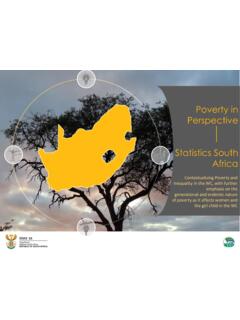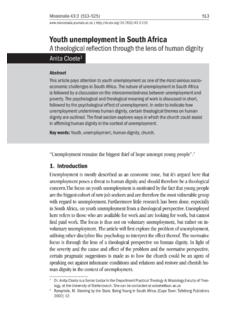Transcription of Playing with genes: The good, the bad and the ugly - Un
1 May FRONTIER TECHNOLOGY QUARTERLY 2019. Playing with genes: The good, the bad and the ugly Genetic technologies1 the ability to manipulate and trans- risks posed by these technologies for increasing inequities in form the properties of cells, seeds, microbes, insects, plants, health outcomes and their potential misuse and abuse. animals and even humans are pushing the frontiers of science and offers us new hope for disease control and cure. I. The good This field has come a long way since Gregor Mendel, the father of genetics, first postulated the rule of heredity in the Genetic technologies are offering new solutions for disease 1850s. Genetic technologies are changing the way we produce control, prevention and cure. They are now being used to food, improving crop yield and preventing catastrophic losses diagnose and treat complex diseases such as heart disease, from droughts, floods and pests.
2 They also are offering new asthma, diabetes and cancer. Genetic technologies may also soon allow us to eradicate malaria, a major health menace in solutions for fighting cancer and many hereditary diseases, many developing countries. improving quality of life and life expectancy. In addition, genetic technologies are increasingly used in criminal justice Eradicating malaria systems to exonerate the innocent and convict the guilty. Such technologies, moreover, have given rise to genetic genealogy, Malaria is one of the most severe public health epidemics in sub-Saharan africa and large swaths of Asia and Latin allowing people to find their ethnic roots. America (Figure 1). It is a leading cause of death, especially While the upsides of genetic technologies are promising, in africa , where a quarter of the population remains at risk we also need to consider their downside risks.
3 Access to gene of contracting the disease. According to the World Health therapies to combat diseases, for example, may be limited to Organization (WHO), one child dies from malaria every those who can afford them, potentially increasing inequality two minutes. In 2017, there were an estimated 219 million in health outcomes within and across countries. Genomic malaria cases worldwide and 435,000 The social research that serves to identify pre-existing conditions can potentially deprive patients from health insurance and medical 2 care. Genetic technologies may exacerbate productivity gaps in agriculture, disadvantaging small farmers, especially in World Economic and Social Survey 2018: Frontier Technology for developing countries, who cannot access or afford genet- Sustainable Development -a flagship publication of the United ically modified seeds.
4 Moreover, there can be unintended Nations Department of Economic and Social Affairs (DESA) - health consequences of genetically modified crop produc- generated considerable interest in new technologies and tion, including increased risks of contamination and loss their development impacts. Inspired by this strong interest, of biodiversity. the Economic Analysis and Policy Division has undertaken to The downside risks can be even uglier. Genetic produce quarterly reviews on frontier technologies, delving modifications can potentially lead to the production of deeper into specific aspects of a new technology. The series designer babies and super-humans and fundamentally alter will identify challenges and raise many questions-and answer a few-while motivating policy research in DESA and the human species. Genomic research can be weaponized beyond.
5 This second edition of the series discusses genetic to target and harm specific population groups. The legal, technologies. The quarterly reviews will be shared and discussed ethical and moral boundaries of using genetic technologies in development policy seminars and social media platforms to are increasingly unclear, creating opportunities for their enrich policy discourse on frontier technologies. misuse and abuse. Weighing potential benefits against risks thus remains an urgent challenge. This Frontier Technology Quarterly discusses the potential of genetic technologies for Kristinn Helgason, Marcelo LaFleur, and Hamid Rashid, Economic improving health and agricultural productivity, two important Analysis and Policy Division (EAPD) of UN DESA, authored this goals of the 2030 Agenda for Sustainable Development, the issue of Frontier Technology Quarterly.
6 Nazrul Islam, Alex Julca, 1 The term broadly encompasses both genetics the study of genes and Hiroshi Kawamura, and Mariangela Parra-Lancourt provided their role passing traits or conditions from one generation to another, and useful comments on the draft. Research support was provided by genomics the study of all of a person's genes (the genome), including Nicole Hunt and Linying He. Hamid Rashid, in his capacity as the interactions of those genes with each other and with the person's environment. Genomics includes the scientific study of complex diseases Chief of Development Research Branch in EAPD, supervised the such as heart disease, asthma, diabetes, and cancer because these diseases production. The views and opinions expressed herein are those are typically caused more by a combination of genetic and environmental of the authors and do not necessarily reflect those of the United factors than by individual genes.
7 Genomics is offering new possibilities for therapies and treatments for some complex diseases, as well as new Nations Secretariat. diagnostic methods (source: ). Economic Analysis and Policy Division w Department of Economic and Social Affairs Figure 1. Countries with indiginous cases of malaria in 2000 and their status by 2017. Source: World Health Organization and economic costs of malaria are significant. Governments and The International Rice Research Institute (IRRI), for societies bear the cost burden of health facilities, personnel, example, has genetically engineered the Stress-Tolerant Rice for drugs, public health campaigns and interventions to fight and africa and South Asia (STRASA), which maintains normal yield contain malaria, diverting scarce resources away from productive even when submerged in flood water.
8 By 2017, more than 8 million economic activities. farmers in South Asia were using the STRASA rice variety. Gene drives3 to combat malaria promise large improvement Adoption of genetically modified crops has been rapid, espe- in health outcomes in many developing countries, particularly for cially in the United States (Figure 2) where GMO crops account for young children and pregnant women who are most vulnerable to more than 80% of planted acres. Brazil, China and India are also the disease. They can alter the life cycle of the parasite or eradicate leading producers of GMO crops. While GMO crops have made it completely. Computer models simulating the gene drive and food production more resilient to pesticide, infestation, drought or other interventions estimate that malaria could be eliminated flooding, they have also raised concerns about direct and indirect from large regions within two decades.
9 The speed and effectiveness costs of production, including cost of seeds, land degradation, envi- of gene drives also make the technique potentially dangerous, as it ronmental sustainability and safety. may trigger unforeseen mutations or affect other insect species. Large farms in developed economies can usually afford the scale and intensity of GMO crop production, potentially disad- Developing resilient food crops vantaging small farmers in developing countries. Not surprisingly, GMO crop production remains concentrated in a handful of coun- Food production is often susceptible to adverse weather, ecological tries, with the United States accounting for 40% of the planted and soil conditions. Genetically engineered (GE) or genetically crop land (Figure 3).6 This raises additional concerns regarding modified organisms (GMO)4 are allowing the production of competition, global supply chain, crop prices, and food security for more resilient crop varieties.
10 A new cost effective and easy-to-use millions in many developing countries. Large-scale GMO crops are technique, known by its acronym CRISPR, has revolutionized the increasingly disadvantaging small farmers in developing countries, process of decoding and precisely editing genetic information of who are unable to compete in the market place on either price or 3 A gene drive is a genetic engineering technology adding, deleting, disrupting, quantity. The GMO seed production is also concentrated among or modifying genes to rapidly spread a particular genetic trait to an entire few large firms who enjoy enormous market power to control offspring population. A gene drive can alter or eliminate an entire species. price and supply of seeds, making small farmers vulnerable to 4 A genetically modified organism (GMO) is an organism in which one or more market manipulation.











